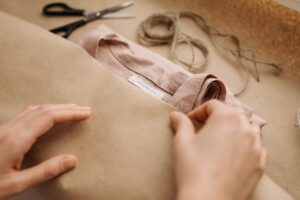More people today want to make better choices when buying clothes. This is why sustainable fashion is becoming very popular worldwide. Sustainable fashion means buying clothes that are good for the environment, use less water, and avoid harmful chemicals. It also means choosing fabrics that are kind to the planet and support better farming and production methods. If you want to shop responsibly and help save the earth, it is important to know about the fabrics used in your clothes. This knowledge will help you pick clothes that last longer and cause less damage to nature.
In this article, I will share some of the most common and best sustainable fabrics that every conscious shopper should know. These fabrics are made with care for the environment and the people involved in making them.
Organic Cotton
Organic cotton is grown without any harmful pesticides or synthetic fertilizers. Unlike regular cotton, which uses a lot of chemicals and water, organic cotton is grown naturally. It helps protect the soil and water from pollution. Organic cotton uses about 70% less water than conventional cotton. Clothes made from organic cotton feel soft and comfortable, and they are also safer for sensitive skin. Choosing organic cotton supports farmers who use eco-friendly farming methods and helps keep the earth healthy.
Linen (Flax)
Linen comes from the flax plant, which needs very little water and no chemicals to grow well. This makes linen one of the most sustainable fabrics available. Linen fabric is strong, breathable, and lightweight. It gets softer every time you wash it, and it can last for many years if taken care of properly. Linen is also 100% biodegradable, so it breaks down naturally at the end of its life. Because of its durability and comfort, linen is perfect for summer clothes and a smart choice for a sustainable wardrobe.
Hemp
Hemp is a highly sustainable fabric that grows quickly without the need for pesticides or herbicides. It uses much less water compared to cotton and is good for the soil because it helps restore nutrients. Hemp fabric is very strong and durable but also softens with wear and washing. It is breathable and naturally resistant to mold and UV light. Hemp farming also helps absorb carbon dioxide from the atmosphere, which fights climate change. Because of all these benefits, hemp is a favorite fabric for people who want long-lasting, eco-friendly clothes.
Tencel (Lyocell)
Tencel is a modern fabric made from wood pulp, usually from eucalyptus trees grown on sustainable farms. Its production uses a closed-loop system that recycles water and solvents, minimizing pollution and waste. This makes Tencel one of the cleanest fabric-making processes. Tencel fabric is soft, smooth, breathable, and biodegradable. It is often used to make shirts, dresses, and activewear. Tencel’s comfort and eco-friendly production make it a popular choice among sustainable fashion brands.
Recycled Polyester
Polyester is a common synthetic fabric made from fossil fuels and is not biodegradable. However, recycled polyester is made by reusing plastic waste like bottles and fishing nets. This helps reduce plastic pollution in oceans and landfills. Recycled polyester saves energy compared to making new polyester and supports circular fashion, where materials are reused instead of thrown away. Although it is still plastic-based, recycled polyester has a much smaller environmental footprint and is often used in sportswear and outerwear.
Fashion magazine articles highlight the importance of knowing about fabrics because the fashion industry is one of the biggest polluters globally. It consumes huge amounts of water, energy, and chemicals and produces a large amount of waste. By choosing clothes made from sustainable fabrics, you help encourage brands to use better, cleaner production methods. Sustainable fabrics usually last longer, so you buy fewer clothes and create less waste. Knowing about sustainable fabrics helps you shop responsibly while also saving money in the long run.

Piñatex (Pineapple Leather)
Piñatex is an innovative and eco-friendly fabric made from pineapple leaf fibers, which are usually thrown away as agricultural waste. This fabric provides an animal-free alternative to leather and helps farmers by giving extra value to their crops. Piñatex is durable and used to make shoes, bags, and accessories. It is becoming very popular in the sustainable fashion world because it reduces waste and animal harm.
Wool (Responsible and Regenerative)
Wool can be a sustainable fabric when sourced from farms that follow responsible and regenerative practices. These farms care for the animals and the land, promoting biodiversity and improving soil health. Regenerative wool farming helps capture carbon in the soil, reducing greenhouse gases. If you want to buy wool products that are eco-friendly, look for certifications like the Responsible Wool Standard (RWS). This ensures the wool is made with respect to animals and the environment.
Cork Fabric
Cork fabric is made from the bark of cork oak trees without cutting the trees down. The bark grows back naturally, so cork is renewable and biodegradable. This lightweight, water-resistant material is often used for wallets, bags, and shoes. Cork is a great alternative to leather because it is eco-friendly and stylish.
Why Sustainable Fabrics Matter
The fashion industry is known for its negative impact on the environment, including heavy water use, pollution from chemicals, and massive textile waste. By choosing clothes made from sustainable fabrics, you help reduce these problems. Sustainable fabrics use fewer resources and produce less waste. They also last longer, which means you don’t have to buy new clothes often. This helps reduce overall consumption and pollution.
Brands today are moving toward more eco-friendly materials because customers want cleaner and greener options. As shoppers, knowing about sustainable fabrics helps you support these positive changes and avoid fast fashion products that harm the planet.
Final Thoughts
Choosing sustainable fabrics is the first move toward building a wardrobe that’s kind to the environment. Materials like organic cotton, linen, hemp, Tencel, Piñatex, and cork are excellent eco-friendly alternatives. When shopping, look for trusted certifications such as GOTS, OEKO-TEX, or Responsible Wool Standard to ensure the products meet sustainability standards.
By supporting sustainable fabrics, you help reduce waste and pollution, promote better farming practices, and encourage the fashion industry to prioritize the planet. Every choice counts in making the world greener.

